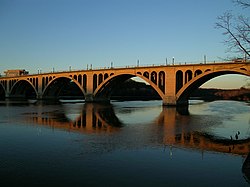Francis Scott Key Bridge (Washington)
|
Key Bridge
|
|
 |
|
| Location |
|
|---|---|
| Coordinates | 38°54′8″N 77°4′13″W / 38.90222°N 77.07028°WCoordinates: 38°54′8″N 77°4′13″W / 38.90222°N 77.07028°W |
| Built | 1923 |
| Architect | Nathan C. Wyeth Max C. Tyler |
| Architectural style |
Classical Revival arch bridge 518.5 meters (1,701 ft) long |
| NRHP Reference # | 96000199 |
| VLR # | DC Local |
| Significant dates | |
| Added to NRHP | March 1, 1996 |
| Designated VLR | October 18, 1995 |
The Francis Scott Key Bridge, more commonly known as the Key Bridge, is a six-lane reinforced concrete arch bridge conveying U.S. Route 29 (US 29) traffic across the Potomac River between the Rosslyn neighborhood of Arlington County, Virginia, and the Georgetown neighborhood of Washington, D.C. Completed in 1923, it is Washington's oldest surviving bridge across the Potomac River.
Key Bridge was added to the National Register of Historic Places in 1996.
Key Bridge replaced the much older Aqueduct Bridge. The first Aqueduct Bridge was built in 1830 to carry the Chesapeake and Ohio Canal across the Potomac to connect with the Alexandria Canal on the Virginia shore. The bridge was converted into a roadway during the American Civil War. In 1866, the canal was restored and a new wooden roadway built over it atop trestles. The 1830 bridge was torn down in 1884, and a new structure built which opened in 1889. The Washington abutment still survives and is located west of the Key Bridge. One pier remains and is located in the river near the Virginia shore.
Proposals were made to replace Aqueduct Bridge as early as 1901. But these proposals were delayed when the McMillan Plan was issued in 1902. The plan's proposals for new bridges across the Potomac called into question whether Aqueduct Bridge should be replaced or merely torn down. In the meantime, Congress approved repairs to the bridge in 1902 1908, and 1913.
In March 1914, Representative Charles Creighton Carlin of Virginia sponsored legislation to replace Aqueduct Bridge with a new, $1 million structure. The Commissioners of the District of Columbia (the city's appointed government) approved the new bridge in June. Controversy over the new bridge immediately broke out. Senator Claude A. Swanson, chairman of the Senate Committee on Public Works, wanted the new bridge built about 3,000 feet (910 m) downstream at the mouth of Rock Creek (at about 30th Street NW), where it would cross Analostan Island and the Potomac River to Rosslyn. Georgetown merchants strongly opposed this plan. There were some in Congress who wanted to repair the existing bridge, but a study by the United States Army Corps of Engineers in August 1914 showed that the existing structure was inadequate for the amount of traffic and too unstable to be saved.Secretary of War Lindley Miller Garrison, who oversaw the Corps, agreed that a new bridge was necessary in December. Rep. William C. Adamson, chairman of the House Committee on Public Works, challenged Swanson and declared that the new bridge should be placed where the old one was.
...
Wikipedia

